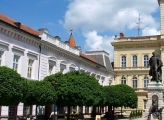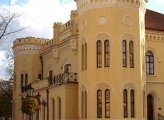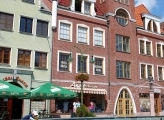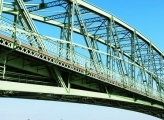Komárno
Komárno
Area:102.807 km² (39.694 sq mi)
Population: 36279
Komárno (Slovak: Komárno; Hungarian: Komárom, colloquially Révkomárom, Öregkomárom) is a town in Slovakia at the confluence of the Danube and the Váh rivers. Komárno was formed from part of a historical town in Hungary situated on both banks of the Danube. Following World War I, the border of the newly created Czechoslovakia cut the historical, unified town in half, creating two new towns. The smaller part is in Hungary as Komárom. Komárno and Komárom are connected by the Elizabeth bridge, and the two towns used to be a border crossing between Slovakia and Hungary until border checks were lifted due to the Schengen Area rules. Komárno is Slovakia's principal port on the Danube. It is also the center of the Hungarian community in Slovakia, which makes up roughly 60% of the town's population.
Komarno, situated at the confluence of the rivers Vah and Danube at the height of 108-115 meters, is one of the oldest settlements in the Carpathian basin. It is a town with rich history. Its territory has been systematically inhabited since the Early Bronze Age. First, the Celts lived here then the Romans who built up a military camp and the town of Brigetio on the right bank of the river Danube and on the northern bank of the river its fortified bridgehead – Celemantia. In the Early Middle Ages – during the movement of Nations – the territory of Komarno was inhabited by the Avars for a longer period of time. These Nomads from Central Asia ruled the Carpathian basin from 568 for nearly 250 years. From this period there were 8 burial places discovered in the territory of Komarno with various materials reflecting the habits of the Avars.
A few years after the Empire of the Avars had dissolved the Moravian-Slavic tribes who were constantly growing stronger tried to subdue the territories which were not occupied by the Avars but then they attacked the remaining Avars too, who were provided protection by the Francs. (year 811). It is not sufficiently examined yet whether the Avars (Onogurs) who stayed in the territory of Komarno in the 9th century belonged to the sphere of the Francs or to the powerful Slavic one.
From the 60s of the 9th century the combative Magyar tribes also took part in the battles between the Francs and the Moravian Slavs. They entered into an alliance sometimes with the former sometimes with the latter tribe. At the end of the 9th century the Magyar tribes occupied the Carpathian basin. During the 10th century they built a fortified enclosure at the confluence of the rivers Vah and Danube. At the time of forming the Hungarian state this place became the centre of the Komarno Committee. At the Komarno Castle which was situated on the crossroads of important overland and water routes and served as the residence of the Committee a settlement was founded which was named in the same way as the Castle. In the earliest documents both the castle and the settlement are referred to as Camarum (1075), Kamarn (1218), Camarun (1268), Kamar (1283), Camaron, Comaron (in a number of documents from the period 1372-1498).
“Villa Camarun” was one of the 23 settlements being under the rule of the Komarno Castle. The first significant privileges which belonged only to towns were vested to the settlement by King Bela IV with a document from 1 April 1265. The privileges of the town which were confirmed and increased by the subsequent rulers contributed to Komarno`s development in the Middle Ages and under the reign of Matthew Corvin the town was flourishing. He had a Renaissance palace built in the castle and he kept visiting it to relax and to enjoy himself. He also arranged the Royal Danube Flotilla whose major base during the Turkish fights became Komarno.
During the Turk occupation Komarno found itself on the border line between the Habsburg and the Turkish Empire. This was the reason why under the reign of Ferdinand I in the middle of the 16th century the castle was turned into a fortress which offered protection for the town. This is how the so-called Old Fortress was formed and during the following fights against the Turks in the 60s and 70s in the 17th century it was extended by the New Fortress.
These fortresses successfully resisted the attacks of the Turkish Army. After expelling the Turks from the country and bringing the rebellion against the Habsburgs to an end thanks to its advantageous position on the crossroads of overland and water routes in the 18th century Komarno became one of the big towns with booming trade and crafts. By the document issued on 16 March 1745 by Maria Theresa the town was afforded royal privileges. The wealthier inhabitants and the aristocracy who settled down here had some Baroque palaces built whereas the Trinities, Franciscans and Jesuits had a number of monasteries and churches built.
The Baroque town constructed in the first half of the 18th century was ruined on 28 June 1763 by a massive earthquake and 20 years later on 22 April 1783 the town was struck by another powerful earthquake. Despite the earthquakes and a number of other natural disasters (floods, big fires, plague and cholera epidemic) Komarno remained a significant centre of trade and crafts until the middle of the 19th century.
The construction of the extensive fortification system of Komarno started during the Napoleonic wars but the events of the 1848/1849 revolution interrupted the work. Komarno as the last bastion of the Hungarian burgeois revolution played an important role during the above mentioned years. However, the town devastated by a big fire and the several month` besiegement lied in ruins. During the years of the Austrian absolutism mainly military objects were built in Komarno. After finishing the fortification system in the 70s of the 19th century the town became the strategic military base of the Austro-Hungarian Monarchy, the town itself, however, lost its economic significance and previous position among the towns in the country.
The beginning of the 20th century brought the first railway bridges along across the rivers Vah and Danube, the first railway tracks connecting Komarno with more distant places in the country, the first industrial factories and in 1896 the community called Ujszony was incorporated to the town on the right bank of the river Danube. This resulted in Komarno gaining space for its development and was once again on the right track. After the Austro-Hungarian Monarchy was dissolved and the state of Czechoslovakia was formed the borders of the country on the river Danube divided the historical Komarno county and the town of Komarno. After the regional reorganization in 1923 the left-bank-part of the town became the centre of the Komarno region. As a frontier town it remained on the verge of economic interest. Employment was offered mainly by the shipyard, the Danube port, the newly-established purchaser of tobacco and the power plant. After setting up the Czechoslovak State Administration, creating new offices and institutions the ethnic composition of the town partially changed. However, the Hungarians still outnumbered the Slovak population and during the years of the first republic it became the cultural and social centre of the Hungarian minority group living in the south of Slovakia. On 2 November 1938 the Vienna Arbitrage resulted in the town being incorporated to Hungary and becoming a county town once again. During the Second World War it was bombarded many times.
After the withdrawal of the front on 30 March 1945 Komarno became a frontier town of Czechoslovakia again. The war ruined the communications, bridges, buildings and a lot of factories. They had to be reconstructed but the circumstances – the repressive measures against the Hungarians between 1945 – 1948 who were deprived of their civil rights, the displacement by forced recruitment of the workforce to the Czech borderland and relocation to Hungary on the basis of a mutual agreement between Czechoslovakia and Hungary about the exchange of the population – made the whole process more difficult.
The construction of the new shipyard in the following years contributed to the development of the town. Its workers were provided with new residential areas. The process of setting up new residential areas and rebuilding the town became more intensive after the flood which struck the town in 1965. The extensive but not always well thought-out reconstructions of Komarno resulted in the fact that from the former town only its historical centre is left. Most of the remaining cultural and historical memorials are here. At the moment Komarno is a busy frontier town of the Slovak republic with 38 thousand inhabitants.
Komarno is the home town of a number of significant people who the town is proud of. The first to be mentioned is the world-famous Hungarian Romantic writer, Mor Jokai who grew up here and in his novels he celebrated the town. Franz Lehar the world-famous composer spent only part of his childhood in Komarno but he always talked about the town with affection even though he never returned here. General Gyorgy Klapka is worth mentioning too as a significant person in the history of the town in spite of the fact that he wasn`t from Komarno. However, in 1849 by not yielding to the superior imperial force but heroically protecting the town he inscribed his name upon the pages of the town`s history. In honour of these people the town raised a monument to each of them. General Klapka`s monument was raised in 1896 on the main square in front of the town hall, Mor Jokai`s in 1937 in front of the museum, Franz Lehar in 1980 in the park close to his former house which was demolished. The trilingual memorial tablet which was placed in 1991 on the third house of Pohranicna street reminds everyone of the fact that the world-famous doctor-researcher dr. Hans Selye spent his childhood and youth in Komarno. He had his final examinations in the 1924/1925 school year in the Benedictine secondary grammar school.
The rich history of Komarno and its surroundings, the life and work of the significant people who are somehow connected to the town are documented in the exhibitions in the Danubian museum in Komarno in the main building of the institution on Palatinova street ( history of the region till 1849, picture gallery), in Zichy Palace Klapka square (modern history of Komarno), furthermore in the building on Palatinova street (commemorative exhibition of Franz Lehar and Mor Jokai, the Orthodox church – exhibition of the Balkan sacral art).





